Teaching ESL to Adults - Module 1
We are excited to release Module 1 of our Teaching ESL to Adults training program....
Read full story.
.
.
Hi, I’m Sandra. I work at Off2Class producing bright, beautiful ESL lesson content to motivate your students and save you time. In this post I’ll show you how to teach ESL students to use comparative adjectives.
Off2Class step-by-step ESL curriculum incorporates grammar and vocabulary together with speaking, listening, reading and writing tasks — every lesson is step-by-step. Each unit is organized around a theme. Before teaching each unit, I think you’ll benefit from a summary of the main points, as well as some helpful tips.
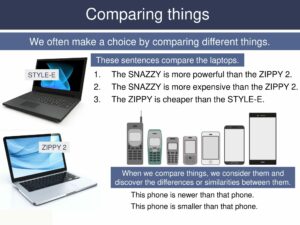
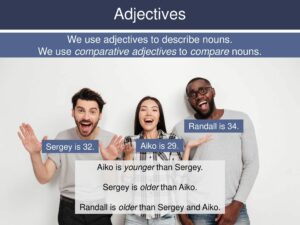
In exploring how to teach ESL students to use comparative adjectives, we’ll start with technology. Technology evolves quickly and our gadgets are constantly changing. In less than a generation cell phones have become as powerful as some computers! Technology is changing how we interact with others, and the smartphone has become ubiquitous as texting replaces voice calls.
We look at changes in smartphones and personal computers to introduce comparative adjectives. In general, comparative adjectives don’t cause many issues for students. The general rule is the one-syllable words take the -er suffix while adjectives with two or more syllables take use more in front of the adjectives. This rule — or tendency — works well for ESL students despite the large number of exceptions.
When introducing comparative forms, avoid comparatives that don’t follow the syllable rule. For example, the comparative form of rude may be ruder or more rude depending on your variety of English, so don’t introduce adjectives like fierce, stupid, true, lonely or tired.
For example, different native speakers will use more tired or tireder, and narrower is more common than more narrow.
Remember to introduce the spelling changes and pay attention to the three irregular comparatives better, worse and farther.
If students have understood comparative adjectives, the superlative won’t pose any issue. The only tip is to enforce the use of the definite article, the. While we don’t use the in every circumstance, it’s better for students to learn this common tendency from the beginning.
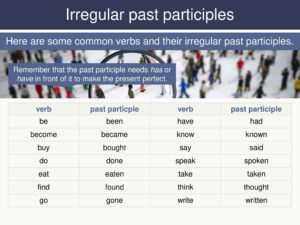
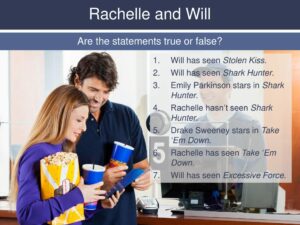 Now that we’ve covered how to teach ESL students to use comparative adjectives, we’ll move on to entertainment. We’ll kick this section off with some grammar.
Now that we’ve covered how to teach ESL students to use comparative adjectives, we’ll move on to entertainment. We’ll kick this section off with some grammar.
Most ESL teachers either love or hate teaching the present perfect. For teachers whose students have a comparable verbs tense in the native language, the form of the present perfect doesn’t present too many challenges.
However, many teachers find it challenging to explain when and why we use the present perfect. In our unit on entertainment, we look at the use of the present perfect for completed actions in the past for an unfinished period of time, In other words, when we use the present perfect to talk about actions that we have or haven’t done up to this point in our lives.
For example:
I have traveled to Spain, but I haven’t traveled in Italy (up to this point in my life).
In this unit, students have the opportunity to talk about their favorite actors. They’ll say what those actors have and haven’t done, and films the students have or haven’t seen. We introduce a number of regular and irregular participles over the four lessons, and we encourage you provide plenty of opportunities to use the present perfect to ensure that students start to use the common irregular participles as soon as possible.
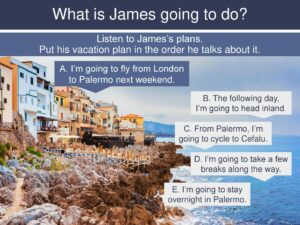
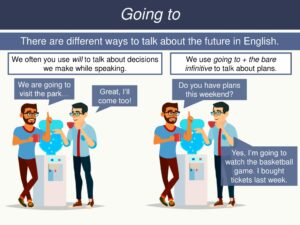
Our last area of focus to teach ESL students about technology, entertainment, and plans, is how to express future plans!
In the final unit of the A2 module, we look at how future plans are expressed using going to and the bare infinitive. Students usually don’t need much of an introduction to going to, as they have generally heard it many times before encountering it in class.
When you teach going to for future plans, make sure you model and drill the form in connected speech. Many teachers still fail to do this, believing that people shouldn’t use forms like /gunna/. The reality is all native speakers use a version of this, even reducing it further to /muna/. It’s up to you to teach the correct form, but make sure that you don’t leave students thinking that they will hear /going to/ in daily speech.
The last grammar we introduce in the A2 module is should and shouldn’t for advice. Students have an opportunity to read travel tips by experts to advise would-be travelers. When teaching should and shouldn’t, you need to be aware of two things. First, like with other modal verbs, students may use the infinitive rather than the bare infinitive.
For example:
You should to carry water at all times, instead of
You should carry water at all times.
Second, students may start to interchange have to with should, which doesn’t cause an issue. However, the negative forms shouldn’t and don’t have to are not substitutes for each other.
For example:
You should eat breakfast is similar in meaning to You have to eat breakfast, while
You shouldn’t eat breakfast is not the same as You don’t have to eat breakfast.
The Off2Class step-by-step ESL curriculum will eventually contain over 250 lessons in 70 units covering all levels. We hope these posts provide an overview to help you use the best digital content tool for ESL teachers.
We hope this post is helpful in showing you how to teach ESL students to use comparative adjectives . Of course there’s more to it than a few simple tips, but we hope that this post presents a few things worth thinking about before you teach the grammar and language in these units.
Leave a reply Cancel reply